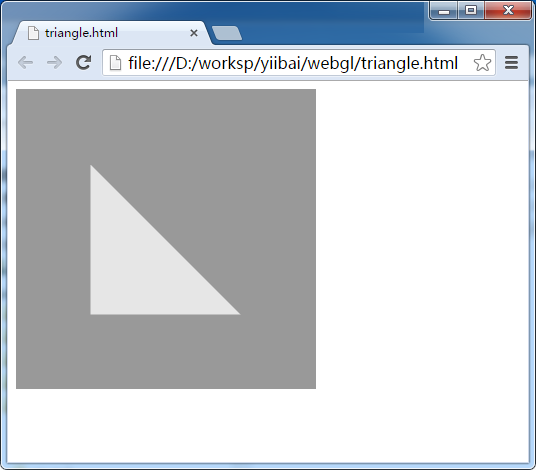在前面的章节,我们讨论了如何使用WebGL绘制三个点。并使用示例应用程序来演示如何画一个三角形。在这两个例子中,我们绘制仅仅使用顶点图元。
绘制更复杂的形状/网格,我们通过一个几何图形索引也一样,如:顶点,向着色器。在本章中,我们将学习如何使用索引来画一个三角形。
绘制三角形所需的步骤
下面的步骤是用来创建一个WebGL的应用程序以绘制一个三角形。
第1步 - 准备Canvas和获取WebGL的渲染上下文
在此步骤中,我们使用的getContext()得到WebGL的渲染上下文对象。
第2步 - 定义几何并将其存储在缓冲区对象
由于我们使用的索引画一个三角形,我们必须通过三角形的三个顶点,包括索引,并把它们存储在缓冲器。
var vertices = [ -0.5,0.5,0.0, -0.5,-0.5,0.0, 0.5,-0.5,0.0, ]; indices = [0,1,2];
第3步 - 创建和编译着色器程序
在这一步中,需要写顶点着色器和片段着色器程序,编译它们,并通过连接这两个程序将创建一个合并程序。
-
顶点着色器 - 在程序的顶点着色器,我们定义向量属性来存储三维坐标,并指定为 gl_position。
var vertCode =
'attribute vec3 coordinates;' +
'void main(void) {' +
' gl_Position = vec4(coordinates, 1.0);' +
'}';
-
片段着色器 - 在片段着色器,我们只分配碎片颜色到gl_FragColor变量。
var fragCode = 'void main(void) {' +
' gl_FragColor = vec4(1, 0.5, 0.0, 1);' +
'}';
第4步 - 关联着色器程序到缓冲区对象
在这一步,我们关联缓冲器对象和着色器程序。
第5步 - 绘制所需的对象
由于我们使用的索引画一个三角形,我们将使用drawElements()。对于这个方法,必须传递索引的数量。indices.length的值表示索引的数量。
gl.drawElements(gl.TRIANGLES, indices.length, gl.UNSIGNED_SHORT,0);
示例 - 绘制一个三角形
以下程序代码显示了如何使用的索引来在WebGL中绘制的一个三角形 -
<!doctype html>
<html>
<body>
<canvas width = "300" height = "300" id = "my_Canvas"></canvas>
<script>
/*============== Creating a canvas ====================*/
var canvas = document.getElementById('my_Canvas');
gl = canvas.getContext('experimental-webgl');
/*======== Defining and storing the geometry ===========*/
var vertices = [
-0.5,0.5,0.0,
-0.5,-0.5,0.0,
0.5,-0.5,0.0,
];
indices = [0,1,2];
// Create an empty buffer object to store vertex buffer
var vertex_buffer = gl.createBuffer();
// Bind appropriate array buffer to it
gl.bindBuffer(gl.ARRAY_BUFFER, vertex_buffer);
// Pass the vertex data to the buffer
gl.bufferData(gl.ARRAY_BUFFER, new Float32Array(vertices), gl.STATIC_DRAW);
// Unbind the buffer
gl.bindBuffer(gl.ARRAY_BUFFER, null);
// Create an empty buffer object to store Index buffer
var Index_Buffer = gl.createBuffer();
// Bind appropriate array buffer to it
gl.bindBuffer(gl.ELEMENT_ARRAY_BUFFER, Index_Buffer);
// Pass the vertex data to the buffer
gl.bufferData(gl.ELEMENT_ARRAY_BUFFER, new Uint16Array(indices), gl.STATIC_DRAW);
// Unbind the buffer
gl.bindBuffer(gl.ELEMENT_ARRAY_BUFFER, null);
/*================ Shaders ====================*/
// Vertex shader source code
var vertCode =
'attribute vec3 coordinates;' +
'void main(void) {' +
' gl_Position = vec4(coordinates, 1.0);' +
'}';
// Create a vertex shader object
var vertShader = gl.createShader(gl.VERTEX_SHADER);
// Attach vertex shader source code
gl.shaderSource(vertShader, vertCode);
// Compile the vertex shader
gl.compileShader(vertShader);
//fragment shader source code
var fragCode =
'void main(void) {' +
' gl_FragColor = vec4(0.0, 0.0, 0.0, 0.1);' +
'}';
// Create fragment shader object
var fragShader = gl.createShader(gl.FRAGMENT_SHADER);
// Attach fragment shader source code
gl.shaderSource(fragShader, fragCode);
// Compile the fragmentt shader
gl.compileShader(fragShader);
// Create a shader program object to store
// the combined shader program
var shaderProgram = gl.createProgram();
// Attach a vertex shader
gl.attachShader(shaderProgram, vertShader);
// Attach a fragment shader
gl.attachShader(shaderProgram, fragShader);
// Link both the programs
gl.linkProgram(shaderProgram);
// Use the combined shader program object
gl.useProgram(shaderProgram);
/*======= Associating shaders to buffer objects =======*/
// Bind vertex buffer object
gl.bindBuffer(gl.ARRAY_BUFFER, vertex_buffer);
// Bind index buffer object
gl.bindBuffer(gl.ELEMENT_ARRAY_BUFFER, Index_Buffer);
// Get the attribute location
var coord = gl.getAttribLocation(shaderProgram, "coordinates");
// Tutorials an attribute to the currently bound VBO
gl.vertexAttribTutorialser(coord, 3, gl.FLOAT, false, 0, 0);
// Enable the attribute
gl.enableVertexAttribArray(coord);
/*=========Drawing the triangle===========*/
// Clear the canvas
gl.clearColor(0.5, 0.5, 0.5, 0.9);
// Enable the depth test
gl.enable(gl.DEPTH_TEST);
// Clear the color buffer bit
gl.clear(gl.COLOR_BUFFER_BIT);
// Set the view port
gl.viewport(0,0,canvas.width,canvas.height);
// Draw the triangle
gl.drawElements(gl.TRIANGLES, indices.length, gl.UNSIGNED_SHORT,0);
</script>
</body>
</html>
这将产生以下结果 -


上一篇:
WebGL绘制点
下一篇:
WebGL绘图的模式
